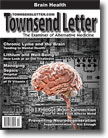Page 1, 2
Frankincense Essential Oil
I have been utilizing essential oils more and more with my patients, and seeing great results. Essential oils, being lipid-soluble, can cross the blood–brain barrier easily and have good penetration into cells overall.
There are a number of constituents that make particular oils good for neurological symptoms. Some of the key ones are sesquiterpenes, because of how easily they cross the blood–brain barrier. These help to oxygenate the tissues, reduce inflammation, and calm the nervous system. They can support the endocrine system and have analgesic effects. Some oils that are high in sesquiterpenes are cedarwood, frankincense, patchouli, vetiver, ginger, ylang-ylang, myrrh, Helichrysum, Melissa, and black pepper.
Frankincense in my view is the very best essential oil for Lyme brain. So long as the highest-quality oils are used, frankincense can safely be taken internally. I have patients either put it directly under the tongue, or swallow it as a capsule or in some cases on the roof of the mouth (preferably toward the back of the mouth at the soft palate). Frankincense can also be put on the soles of the feet; the soles are a good entry point for essential oils, as the skin is quite thin, and yet the pores are the largest there of anywhere on the body, so systemic absorption is rapid and effective. Yet others apply it on the temples or the base of the skull.
Patients love frankincense – it helps with brain fog, focus/concentration, and emotional balance. I have a handful of patients who have seizurelike activity that is now controlled with daily use of frankincense. I have many more who report that their brains are so much clearer since using frankincense.
Acetyl-L-Carnitine
Acetyl-L-carnitine has long been used for brain and cognitive support, and there is much research supporting its use and benefit. It is much more absorbable than regular L-carnitine, and the acetyl-L form has superior blood–brain barrier penetration, which is desirable for those needing help with Lyme brain.
There are several mechanisms by which acetyl-L-carnitine helps the brain. It is a nutrient that helps to produce energy, thus fueling the cells, boosting their metabolism and improving their function.10
It also helps to metabolize fat and cholesterol so that the brain does not get "clogged" with plaques and deposits. Acetyl-L-carnitine can help to prevent the buildup of amyloid plaque, which can contribute to cognitive decline. It boosts levels of brain-derived neurotrophic factor (BDNF), which helps to repair damaged cells and even produce new brain cells. Acetyl-L-carnitine boosts nerve transmission and supports nerve regeneration. It also helps to repair myelin sheaths, as well as any damage to the blood–brain barrier caused by toxins, inflammation, and so on. It does this by boosting the antioxidant enzymes that naturally protect the barrier from toxic stress. Since we know that inflammatory damage to the blood–brain barrier can contribute to cognitive issues, neurological degeneration, reduced learning, memory decline, and depression, acetyl-L-carnitine can help to offset such damage and for this reason alone is an important nutrient.
In terms of neurotransmitters, we know that acetyl-L-carnitine supports acetylcholine. It also has been found to support dopamine levels and prevent the age-related decline of dopaminergic receptors.11 Another study showed that acetyl-L-carnitine increased norepinephrine in the hippocampus and serotonin in the cortex. Supporting norepinephrine and serotonin in the brain can help with depressive symptoms as well as cognitive deficits.12
Acetyl-L-carnitine may be one of the most important nutrients for the brain, given that it boosts metabolism, acts as a neuroprotectant, helps the integrity of both the blood–brain barrier and the myelin sheaths around nerves, and, perhaps most importantly, can repair already damaged nerve cells and structures, and promote creation of new, healthy ones.
Curcumin
Curcumin, a constituent of turmeric, has been used for centuries as an anti-inflammatory and antioxidant. It is also used in autoimmune issues to regulate immune function. There are many studies demonstrating its efficacy in reducing inflammation, and various mechanisms reported. One of the ways it reduces inflammation is by reducing pro-inflammatory cytokines that are found to be elevated in Lyme patients. As an antioxidant, curcumin has been found to increase levels of vitamins C and E, and prevent lipid peroxidation and oxidative damage.13
Equally beneficial for Lyme brain is evidence that curcumin can help regenerate and repair cells in the brain. Research shows that a component of turmeric known as aromatic-turmerone can increase neural stem cell growth in the brain by up to 80%.14 Neural stem cells differentiate into various types of neurons – nice, new, healthy neurons! The study found that the number of actual stem cells produced increased with exposure to curcumin, and also that the stem cells increased the number of fully differentiated neural cells.
Curcumin may also be protective against various toxic metals such as copper and aluminum.15,16 Certainly toxic metals are common in Lyme patients and can compound the effects of Lyme brain.
Curcumin has been found to enhance DHA levels in the brain. DHA is one of the vital fatty acids that support brain health – deficiencies have been linked to several cognitive disorders, including anxiety. DHA is either obtained through the diet or created from dietary precursors; however, the conversion rate from dietary precursors is low. Curcumin has been shown to increase conversion to DHA from the precursor alpha-linolenic acid.17
Curcumin is a very safe and nontoxic substance with a good track record of success. It has multiple benefits – regulating the immune system, reducing inflammation, acting as a neuroprotective agent, and promoting neural regeneration.
Amino Acid Therapy
As we know, one of the contributing factors in Lyme brain is an imbalance in neurotransmitters, which can cause issues such as anxiety, depression, and problems with memory, cognition, and mental processing – really, all the things that we associate with Lyme brain.
Any neurological illness can deplete neurotransmitters. Neurological illness creates a higher need and demand for neurotransmitters, so there is a double-edged sword of increased need with depleted supply. Methylation defects also affect neurotransmitter production and utilization.
Amino acid therapy is a way to naturally and safely increase the supply of the raw materials that the body needs to produce neurotransmitters. We are supplementing with the building blocks so that the body can create more neurotransmitters for itself.
Each neurotransmitter has its own pathway and uses different amino acids.
The serotonin pathway starts with tryptophan and moves through 5-HTP to become serotonin. Interestingly, serotonin is converted to melatonin, so people with insomnia can also benefit from supporting the serotonin pathway.
I utilize 5-HTP extensively to support serotonin production. 5-HTP tends to be calming and balancing, and relieves depression.
The epinephrine pathway uses the amino acid phenylalanine, moving through tyrosine to become dopamine, norepinephrine, and epinephrine. Tyrosine in supplemental form is helpful for depression wherein there is extensive fatigue, low moods, apathy, low libido, and poor concentration and focus. I choose tyrosine when "the blahs" seem to be dominant in the depression picture, and 5-HTP more when feeling wired and anxious occurs along with it. Some people do well with both, but of course I recommend starting one at a time.
The GABA pathway starts with glutamine. However, in this particular case, we actually supplement with GABA itself. One reason for this is that it is available in supplement form as actual GABA, and also, while glutamine is an amino acid that can have some benefit in the brain, high glutamate is excitatory and causes more problems than it solves. Therefore to avoid the risk of too much glutamate actually opposing the desired result, a calmer brain, we supplement with GABA itself. I have found GABA to be most helpful for anxiety.
Amino acid therapy is a very safe way to support Lyme-brain recovery – it can lead to a more balanced and even mood, less depression and anxiety, better focus, and greater concentration.
Conclusion
These are just some of the modalities and supplements that I use to help with the cognitive and psychoemotional symptoms of Lyme disease. There are many others that can be helpful, and we didn't even get to touch on the dietary elements! My book, Lyme Brain, due for publication early 2016, will contain much more information on how to help. Sign up to be notified when the book is published at www.LymeBrainBook.com.

Notes
1. Rissenberg M., Chambers S. Distinct pattern of cognitive impairment noted in study of Lyme patients. Lyme Times. 1998 Jan–Mar;20:29–32.
2. Miklossy J, Kasas S, Zurn AD, McCall S, Yu S, McGeer PL. Persisting atypical and cystic forms of Borrelia burgdorferi and local inflammation in Lyme neuroborreliosis. J Neuroinflammation. 2008;5:40.
3. Miklossy J, Kis A, Radenovic A, et al. Beta-amyloid deposition and Alzheimer's type changes induced by Borrelia spirochetes. Neurobiol Aging. 2006;27:228–236.
4. Cartwright MJ, Martin S, Donta S. A novel toxin (Bb Tox 1) of Borrelia burgdorferi [abstract]. Available at http://www.actionlyme.org/Donta.htm.
5. Jernigan D. Ammonia [online article]. Jernigan Nutraceuticals. http://www.jnutra.com/Ammonia.html.
6. Forsgren S. Kryptopyrroluria (aka hemopyrrollactamuria): a major piece of the puzzle in overcoming chronic Lyme disease. Explore! 2009;18:6.
7. Xia D, Yu X, Liao S, Shao Q, Mou H, Ma WJ. Protective effect of Smilax glabra extract against lead-induced oxidative stress in rats. Ethnopharmacology. 2010 Jul 20;130(2):414–420.
8. Lehmann M, Regland B, Blennow K, Gottfries CG. Vitamin B12-B6-folate treatment improves blood-brain barrier function in patients with hyperhomocysteinaemia and mild cognitive impairment. Dement Geriatr Cogn Disord. 2003;16(3):145–150.
9. Tangney CC, Aggarwal NT, Li H, et al. Vitamin B12, cognition, and brain MRI measures: a cross-sectional examination. Neurology. 2011 Sep 27;77(13):1276–1282.
10. Smeland OB, Meisingset TW, Borges K, Sonnewald U. Chronic acetyl-L-carnitine alters brain energy metabolism and increases noradrenaline and serotonin content in healthy mice. Neurochem Int. 2012 Jul; 61(1):100–107.
11. Sershen H, Harsing LG Jr, Banay-Schwartz M, Hashim A, Ramacci MT, Lajtha A. Effect of acetyl-L-carnitine on the dopaminergic system in aging brain. J Neurosci Res. 1991 Nov;30(3):555–559.
12. Smeland OB, Meisingset TW, Borges K, Sonnewald U. Chronic acetyl-L-carnitine alters brain energy metabolism and increases noradrenaline and serotonin content in healthy mice. Neurochem Int. 2012 Jul;61(1):100–107.
13. Rai B, Kaur J, Jacobs R, Singh J. Possible action mechanism for curcumin in pre-cancerous lesions based on serum and salivary markers of oxidative stress. J Oral Sci. 2010;52(2):251–256.
14. Hucklenbroich J, Klein R, Neumaier B, et al. Aromatic-turmerone induces neural stem cell proliferation in vitro and in vivo. Stem Cell Res Ther. 2014;5(4):100.
15. Wan XH, Li YW, Luo XP. Curcumin attenuated the lipid peroxidation and apoptotic liver injury in copper-overloaded rats. Zhonghua Er Ke Za Zhi. 2007 Aug;45(8):604–608.
16. Sood PK, Nahar U, Nehru B. Curcumin attenuates aluminum-induced oxidative stress and mitochondrial dysfunction in rat brain. Neurotox Res. 2011 Nov;20(4):351–361.
17. Wu A, Noble EE, Tyagi E, Ying Z, Zhuang Y, Gomez-Pinilla F. Curcumin boosts DHA in the brain: implications for the prevention of anxiety disorders. Biochim Biophys Acta. 2015 May;1852(5):951–961.

Dr. Nicola McFadzean Ducharme is owner and medical director of RestorMedicine, an integrative medicine clinic based in San Diego, California. She has been treating Lyme patients for over 10 years using a combination of allopathic and naturopathic modalities. She is the author of The Lyme Diet and The Beginner's Guide to Lyme Disease.
Page 1, 2
|
![]()
![]()
![]()





